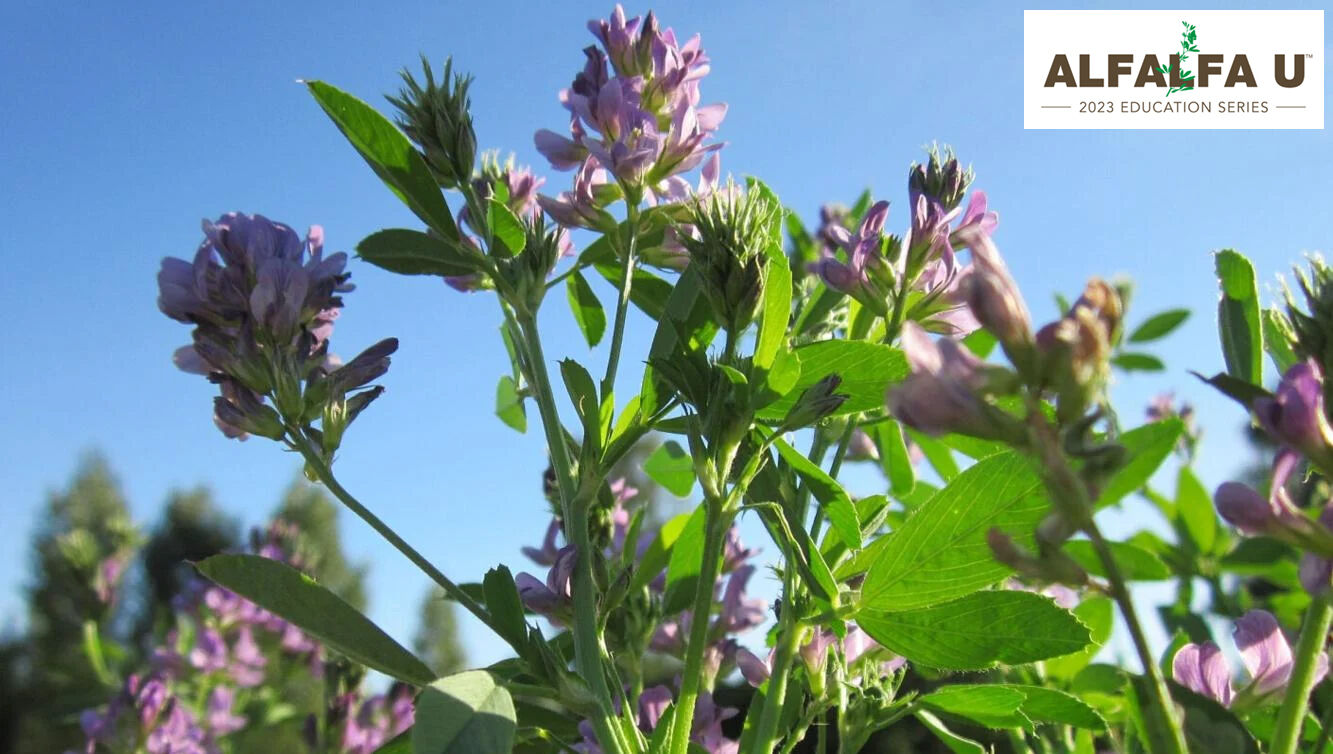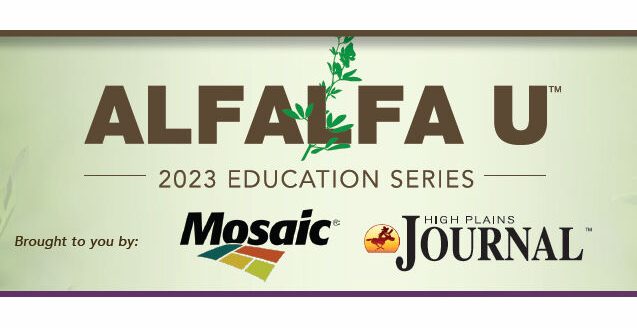Sage advice for alfalfa growers facing water limitations—whether drought or restrictions in irrigated fields—is to plan long term.
Alfalfa is a multi-year perennial and a drought year can be followed by a wet year. If the crop is taken care of it will pay dividends, according to experts.
Don Miller, an alfalfa consultant based in Nampa, Idaho, said if non-irrigators are facing drought conditions the key is to minimize stress on the plants by regularly scouting for insects. They also need to test for nutrient deficiency, including boron.
Miller spent more than 30 years as an alfalfa breeder and most recently was director of product development for Alforex Seeds for 15 years. Miller said growers should avoid the temptation to harvest short top growth that is less than 5 to 6 inches due to drought. The short top growth serves a purpose of maintaining plant health during drought conditions, allowing the alfalfa stand to recover when adequate moisture returns, he said.
Miller said another thing to consider is that “under drought conditions you have less top growth and the plant does not need as much fertilizer.”
Glenn Shewmaker, an emeritus professor and forage specialist at the University of Idaho, said water stress will shorten the internodes of stems, which results in a higher leaf-to-stem ratio. Forage quality is improved but yield is reduced. The water stress also causes plants to mature more rapidly and set flowers early. Stress will increase lignin concentration that significantly reduces digestibility of the forage.
When moisture is limited due to drought conditions Miller said growers should be realistic and consider reducing cuttings by one or more depending on the severity of the drought.
“Alfalfa growth is based on water,” Miller said. “One of the advantages of alfalfa, compared to other crops, is you generally get some forage (one to two cuts) even under drought conditions.” This usually occurs in the spring due to winter moisture and cooler spring growing conditions. Also these spring cuts have better forage quality due to a better leaf-to-stem ratio in comparison to forage produced in the hot summer months.
Overcompensation
The amount of plant nutrients taken up by alfalfa is primarily a function of an increase of yield, which drives water usage, Shewmaker said.
“Weather, of course, is the primary driver of evapotranspiration. Sunlight, humidity, and wind are the major factors affecting water losses from the soil and plants,” Shewmaker said. “Alfalfa evolved in an arid climate and will close stoma when water stressed, resulting in less photosynthesis and plant growth.”
A nutrient of concern is nitrogen, which is taken up in the nitrate form and produced by the rhizobia bacteria in the root modules, Shewmaker said. When growth (yield) is reduced, the nitrates can accumulate too high concentrations because they are not being used in the synthesis of amino acids and protein.
Drought stressed forages, including alfalfa, should be tested for nitrate concentrations because high concentrations can cause abortions and death in livestock, he said.
“No nitrogen fertilizer or manures should be applied to alfalfa if drought is anticipated,” Shewmaker said.
Soils should be tested for phosphorus before droughts and phosphate fertilizers applied if they are below sufficient levels. “Phosphorus is very important for good root growth and development, which can improve the plant’s ability to be present in greater soil volume and improve soil moisture availability.”
Shewmaker said potassium is another important nutrient that is essential for plant growth and water use efficiency. A soil test is the best indicator of potassium sufficiency. Miller also advises growers to stay on top of nutrient tests and he notes in most cases when drought occurs less growth means less minerals are drawn out of the soil.
Irrigation restrictions
Miller said irrigators may also face challenges because allocations from water districts or government agencies may restrict how much they can use. In some states they may be limited to 70% of full allocation or in some cases even less, so growers need to plan ahead.
“If they know they are going to be limited, one possibility is to fully irrigate less acres. Instead of watering 200 acres perhaps focusing on their best 100 acres that has the highest yield potential,” Miller said.
The consultant said growers then have forage to sell off those premium acres and while the balance of the non-irrigated acres is left to go into a drought-induced dormancy. Research has shown that these acres often recover fully once water is restored later. He also said growers should avoid trying what he termed the “starvation diet” where less water is applied after each cutting. The economics of this approach is less favorable because yield is going to be lower and yet the cost of operating harvest equipment will not be reduced.
“Many researchers are suggesting that the best and possibly the most economical approach is to use your water early for the spring and/or early summer cuttings, then when water is no longer available letting the stand go into a drought induced dormancy,” Miller said. “The earliest cuts are the ones with the highest yield and quality and hay prices are generally higher coming out of the winter.” Also, these early cuts tend to capture the majority of the seasonal yield.
In a four-cut system the first cut provides 38% of total seasonal yield, he said. Since water use efficiency is lower in the summer those cuts generally have reduced yields.
Withholding irrigation during the summer months results in a drought-induced dormancy, Miller said. Alfalfa plants will generally survive a summer drought period because alfalfa has deep roots—15 to 20 feet—and can better access moisture from deep in the soil profile. For this reason, alfalfa is considered a relatively drought-tolerant crop compared to shallow-rooted crop options.
Shewmaker said growers should match irrigation to evapotranspiration losses as close as possible. Water use efficiency is highest in the spring. That means more yield per unit of water is highest in the first cutting and lowest in the summer.
Possible adjustments
Weed and pest control are more critical in drought-stressed alfalfa, Shewmaker said, and requires growers to plan ahead.
Miller said growers should not purchase seed based on price but instead focus on having a good variety with pest resistance and drought tolerance. A good variety allows the plant to deal with stress. “A good variety generally produces the highest yields under good conditions and also have more yield and quality even when conditions are not as good.”
“Proper variety selection, rather than buying seed based only on price, can improve a grower’s chances of profitable production in both wet and dry years.” New varieties selected for drought tolerance are now being developed. The drought-tolerant trait is also being combined with salt tolerance to enhance yields to both forms of stress, since soil salinity often increases in droughts, Miller said. During drought periods, salts tend to accumulate in the soil profile since there is less water to leach soil salts out of the root zone. This increase in salinity can negatively affect production. New salt-tolerant varieties can improve stand establishment in saline soils and have the potential to increase yields in drought or saline stress conditions.
Other considerations
Management decisions should be made to reduce plant stress by monitoring fertility, insects and considering reduced harvest frequency, Miller said. He reiterated the importance of irrigators focusing on the early cuts when water use efficiency is highest and avoiding harvesting short-top growth. Miller also noted that cutting at prebud to bud stage can reduce water use per cut as an early cut uses less water than fully mature alfalfa. A seven-day delay from bud to full flowering uses 1.5 to 2.45 inches of water.
Shewmaker said growers should consider setting their harvest to meet forage quality criteria for their market and not by the calendar.
Dave Bergmeier can be reached at 620-227-1822 or [email protected].




